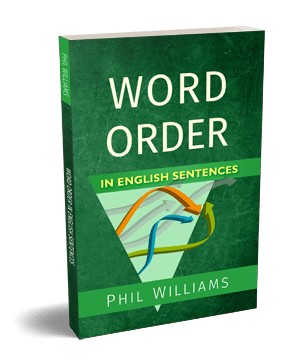
Continuing from the plan I laid out in my recent blog post, we’re into the second month of me giving my grammar guides away free on the website. For all of October, you can now download The English Tenses Practical Grammar Guide absolutely free.
As a quick recap, with the website growing less visible and my own posts slowing down, I want to do what I can to keep sharing the material that’s already there, and this is the second of four coming offers.
To introduce and reflect on the book, I’ve prepared another look back at its history, too, covering where the idea came from and how it grew to be successful. This book, more than any I’ve written, took me on quite a journey, and really gave me a drive to press on through its early obstacles.
This story may be familiar to many of you by now, but here it is again.
Where did The English Tenses Come from?
The English Tenses Practical Grammar Guide came to me as an idea when I was teaching and found that exploring the practical differences between the tenses and their aspects worked as a solid starting point for most of the new students I had. It always tended to help build solid foundations, even with issues which did not initially seem related to verbs, as the aspects of English, covering the past, present and future in simple, continuous and perfect forms, form basic building blocks of the language.
These issues are covered in plenty of other grammar guides, with the essential patterns and rules quickly from the likes of Murphy’s Practical English in Use. The patterns are typically presented very briefly, though, and it struck me that students would benefit from a deeper analysis of the tenses, studying the nuances with more examples and specific differences, to really clarify understanding.

The original cover design, in circulation for a few years. The image was designed by Bob Wright, with the layout (super simple!) done by me in Microsoft Word!
This idea came as I was developing an interest in publishing online content. When I created this website, my English tenses timeline was the first page to really spread across the internet, and people still visit and reference it now. I was also embarking on self-publishing, working on the release of my first novel, the eclectic Wixon’s Day.
I wrote The English Tenses, drawing together research from other books and looking back over notes I’d created myself to help private students. I worked with an artist, Bob Wright, to illustrate the guide, making it colourful with room for notes, all with the idea of creating an engaging and adaptive reading experience. I was then lucky enough to receive plenty of feedback from English teachers across the world who generously looked at particular sections.
From there, though, I then needed to think about actually reaching people with the book and selling it. This was to prove much harder than writing it!
A Difficult Beginning
I spent about three years trying to market The English Tenses Practical Grammar Guide with very little success. I contacted countless reviewers, ran adverts and book promotions and tried promotions on this website. Nothing worked.
In the midst of this, I made the biggest financial misstep of my publishing career (so fire!) by hiring a marketing firm to help out. I believed in this book, if I could just crack the advertising, and I had a little money set aside, so I decided to trust the process to other professionals. One turned me down, saying they did not know how to profitably market the book, while another (highly respected) proved less scrupulous and took it on for a big fee with spurious promises for results. They started out incredibly enthusiastic, but once the campaign started they did little more than set up some basic promos and send out a few emails – little more than the things I’d already tried. This cost me a lot of time and money (thousands), and the result was a couple of new reviews and no notable sales.
This made me so miserable I wanted to put it behind me and didn’t think to take up these failings with the marketing firm, though looking back I certainly should’ve done. Instead, I got over it by determining to make up for what I’d lost by finding another way to sell the book. At last, after I kept testing and testing, I made a breakthrough with Amazon ads (encouraged, admittedly, more by sales of Word Order in English Tenses, whose story you can read here!).
At the end of 2016, after over 2 years, The English Tenses had sold about 500 copies. It was in mid-2017 that the ads started working, and by October 2017, over 3 years since its release, The English Tenses crossed the 1,000 sales mark. Two months later it finally turned a profit, making up for all I lost with the marketing firm.
I was really lucky here, marketing books on Amazon in areas that no one else was covering. My books quickly shot up to bestseller status in their categories. Years after they had been released with little fanfare, my ELB grammar guides were the most popular TEFL books on Amazon, and they stayed that way from the end of 2017 right until mid-2019.

The moment it became a Kindle bestseller – still with the old cover. It now has over 280 ratings!
How the Book and Its Contents Developed
During this process, I revised the book and often rethought parts; the doubts of its worth rarely went away, considering I’d done all this on my own steam without a team of editors backing me! I was mortified to discover there were typos in the earliest versions – in one instance, the book said “present perfect” where it should have been “past perfect”, which is dangerous in teaching material!
The full-colour book was also much more expensive to print, and I never produced a black and white alternative, which would’ve made a lot more profit (but people seemed to like the colour!). Amazon also charged me a higher percentage as a “download fee” because of the images the book included; between that and everything I spent on ads, they have extracted far more money from the book than me, I fear.
I worried that the book was not comprehensive enough, or accurate enough (e.g. was it right to talk about aspects as tenses, which is not strictly grammatical for some). One chap emailed me to ask about a list of dozens of “tenses” I wasn’t even familiar with. The book got some very negative reviews and I occasionally a particular type of teacher would email me complaining about how it contradicted incredibly particular and rigid rules (though that was rather the point).
Yet for its issues, and long journey to success, I always believed that despite whatever problems the book had, the world was better for it, and I hoped most students could derive at least a little extra knowledge from it. It’s with that in mind that I’m continuing to share it where I can, and this month am offering it up for free.

Get The English Tenses Practical Grammar Guide
This bestselling grammar guide is available in eBook and paperback from all major stores, and for the month of October 2025 you can get it absolutely free on my website!






